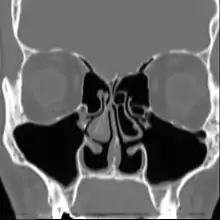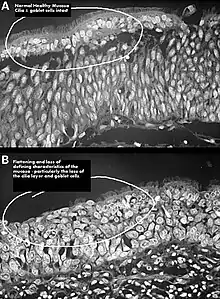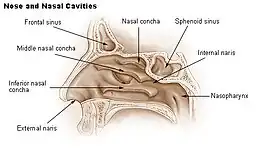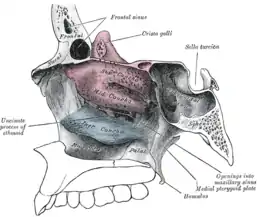| Empty Nose Syndrome | |
|---|---|
| Other names | Secondary atrophic rhinitis |
 | |
| Altered nasal anatomy after bilateral subtotal inferior turbinectomy, the removal of most turbinate tissue. | |
| Specialty | Otolaryngology |
| Symptoms | Sensation of nasal suffocation despite clear airway |
| Complications | Hyperventilation syndrome, depression, anxiety, fatigue |
| Usual onset | Following surgery or injury to the nasal interior |
| Differential diagnosis | Anxiety, Hyperventilation |
| Treatment | Artificial nasal moisture, experimental corrective surgeries |
| Frequency | Unknown, but considered rare in medical literature |
Empty nose syndrome (ENS) is a clinical syndrome, the hallmark symptom of which is a sensation of suffocation despite a clear airway. This syndrome is often referred to as a form of secondary atrophic rhinitis. ENS is a potential complication of nasal turbinate surgery or injury.[1][2] Patients have usually undergone a turbinectomy (removal or reduction of structures inside the nose called turbinates) or other surgical procedures that injure the nasal turbinates.
ENS patients may experience a range of symptoms. Commonly reported are feelings of nasal obstruction, nasal dryness and crusting, and a sensation of being unable to breathe.[3]
The overall incidence of ENS is unknown due to the small body of epidemiological study and the lack of a dedicated International Classification of Diseases (ICD-10) code, which would allow incidence reporting of the syndrome. In a 2019 study in the Facial Plastic Surgery Clinics of North America journal, study lead Jason Talmadge, MD posited that "many cases likely go unrecognized or underdiagnosed, and therefore unreported."[4]
The condition is caused by injury to the nasal turbinates, particularly with nasal procedures. This includes both minor procedures as well as total turbinate resection. It is usually observed in patients with unobstructed nasal passages following surgical intervention who report sensations of suffocation or obstruction following recovery. Early literature attributed ENS to complete turbinate resection, but later research demonstrated the syndrome in patients who had undergone a range of procedures that involved nasal turbinates.[3][5][6][7][8]
The syndrome's existence as a distinct medical condition is controversial, with adoption by a growing body of ear, nose and throat (ENT) practitioners and plastic surgeons. ENS is not fully understood and practitioner knowledge about altered nasal breathing in turbinate surgeries varies. Understanding why some patients exhibit ENS symptoms while others do not and incorrectly attributing symptoms to psychological causes such as anxiety are common reasons ENS patients do not receive care.[3] ENS as a distinct condition is subject to debate, including whether it should be considered solely rhinologic or whether it may have neurological or psychosomatic aspects. Growing awareness of the syndrome and an increasing body of research has led to more acceptance by ENT practitioners.[3][5][9][10][11][12]
Signs and symptoms
The major symptoms of ENS include a sensation of suffocation, nasal dryness, nasal burning, nasal crusting, and an impaired sense of airflow through the nose in patients who have had surgery or injury to nasal turbinates.[13] ENS can greatly reduce a patient's quality of life and many patients struggle to complete activities of daily living. While ENS is physical in its origin, many ENS patients also struggle with depression, anxiety, and sleep disturbances.[14] Individuals with ENS may experience all or some of these symptoms.
A limited study of ENS patients found that ENS is associated with hyperventilation syndrome (HVS) in 77.3% of the study population. The study suggests that there could be an epidemiological link between ENS and HVS. Further studies are required to confirm these results. The authors hypothesize that the link between ENS and HVS could be explained by the nasal injury that occurs to the turbinates that alters the respiratory control system.[15]
A 2023 study found that ENS patients scored significantly higher on the Epworth Sleepiness Scale than control groups, and that severity of ENS symptoms correlated with severity of sleepiness.[16] Sleep apnea was found to correlate with severity of ENS symptoms and high BMI in a 2022 study.[17]
Cause
The cause of ENS is due to the body not accepting the new airflow in the nasal passages following surgical procedures. The nose is an incredibly complex area of the body and one that has been very poorly researched in terms of the effects on aerodynamics from surgical procedures. In many patients with ENS, the airflow is modeled as being more turbulent with less laminar flow across the mucosa. This change in airflow leads to an imbalance of CO2/O2 levels in the body, which will show hyperventilation-like symptoms in patients. This reduced amount of mucus in the nose can also be attributed to the change in airflow often resulting in dry cool air hitting the back of the patient's throat.
One possible cause may be changes to the nasal mucous membrane and to the nerve endings in the mucosa resulting from chronic changes to the temperature and humidity of the air flowing inside the nose, caused in turn by removal or reduction of the turbinates.[3][5] Direct damage to the nerves may be a result of surgical intervention; however, as of 2015, there is no technology that allows the mapping of the sensory nerves within the nose, so it is difficult to determine whether this is causative of ENS.[3] Investigators have been unable to identify consistent diagnostic or precipitating features, psychological causes leading to a psychosomatic condition have been proposed.[3][9][10][12]

There seems to be a relation between reduced levels of nasal nitric oxide and depression/anxiety symptoms in ENS patients. Both have been shown to be reversible via implantation surgery.[18]
It has been proposed, that the airflow in ENS patients is changed so that most of the air flows through the middle meatus, compared to most of the air flowing through the inferior meatus in healthy individuals. This can be corrected via inferior meatus augmentation (IMAP surgery).[19]
Diagnosis
No consensus criteria exist for the diagnosis of ENS and many ENTs will wait a year before diagnosing in hopes the patient accepts the new airflow; it is typically diagnosed by ruling out other conditions, with ENS remaining the likely diagnosis if the signs and symptoms are present.[3][5][9] A "cotton test" has been proposed, in which moist cotton is held where a turbinate should be or in various locations in the nasal passages, to see if it provides relief and an airflow pattern that allows for natural breathing; while this has not been validated nor is it widely accepted, it may be useful to identify which people may benefit from surgery.[3][5][9]
As of 2015, protocols for using rhinomanometry to diagnose ENS and measure response to surgery were under development,[5][9] as was a standardized clinical instrument (a well defined and validated questionnaire) to obtain more useful reporting of symptoms.[9]
A validated ENS-specific, 6-item questionnaire called the Empty Nose Syndrome 6-item Questionnaire (ENS6Q) was developed as an adjunct to the standard Sino-Nasal Outcome Test 22 (SNOT-22).[20] The ENS6Q is the first validated, specific, adjunct questionnaire to the SNOT-22. It can more reliably identify patients suspected of ENS.[21] The ENS6Q is gaining usage in studies on ENS.
Classification


Four types have been proposed:[22]
- ENS-IT: Inferior turbinate (IT) was fully or partially resected
- ENS-MT: Middle turbinate (MT) was fully or partially resected
- ENS-both: Both the IT and MT were both at least partially resected
- ENS-type: Patient appears to have adequate turbinate tissue but suffers ENS symptoms due to damage to the mucosal surface of the turbinates.
Prevention
Attempt non surgical methods for an extended period of time prior to surgical intervention. Avoid any unnecessary nasal surgery, avoid any surgical treatment to the turbinates and septum, seek multiple consults for any nasal surgery, conduct imagery on the nasal passages prior to any surgical treatment, seek opinions from surgeons familiar with ENS.[3][23] Many surgeons will tell patients that ENS is only seen in patients that have excessive turbinate reduction, but studies have shown that any surgery/procedure involving the nasal turbinates can potentially lead to ENS. For this reason it is critical that anyone planning any surgery to the nose for function or appearance should be aware of the high risk of ENS developing if the body does not accept the new airflow and exchange of gasses.
Treatment
Treatment of ENS by many ENTs is extremely limited with very marginal success rates once diagnosed. Initial treatment is similar to atrophic rhinitis, namely keeping the nasal mucosa moist with saline or oil-based lubricants and treating pain and infection as they arise; adding menthol to lubricants may be helpful in ENS, as may be use of a cool mist humidifier at home but has limited success and many ENT patients seek treatment from the few ENTs well educated in ENS surgical techniques.[3] For people with anxiety, depression, or who are obsessed with the feeling that they can't breathe, psychiatric or psychological care may be helpful.[3][9]
In some people, surgery to restore missing or reduced turbinates or various fillers that correct the airflow in the nose may be beneficial.[3] Corrective surgical methods are experimental and limited to a few ENT practitioners worldwide.

A 2015 meta-analysis identified 128 people treated with surgery from eight studies that were useful to pool, with an age range of 18 to 64, most of whom had been experiencing ENS symptoms for many years. The most common surgical approach was creating a pocket under the mucosa and implanting material - the amount and location were based on the judgement of the surgeon. In about half the cases a filler such as noncellular dermis, a medical-grade porous high-density polyethylene, or silastic was used and in about 40% cartilage taken from the person or from a cow was used. In a few cases hyaluronic acid was injected and in a few others tricalcium phosphate was used. There were no complications caused by the surgery, although one person was over-corrected and developed chronic rhinosinusitis and two people were under-corrected. The hyaluronic acid was completely resorbed in the three people who received it at the one year follow up, and in six people some of the implant came out, but this did not affect the result as enough remained. About 21% of the people had no or marginal improvement but the rest reported significant relief of their symptoms. Since none of the studies used placebo or blinding there may be a strong placebo effect or bias in reporting.[9]
Outcomes
Data measuring the prevalence of Empty Nose Syndrome (ENS) after turbinate surgery is limited to a few single surgeon studies with variable results. Measuring prevalence is challenging as ENS symptoms may not show up for many years after the surgery and the surgeon may no longer be following the patients. Quantifying prevalence will also depend on a valid, standardized definition.[24][4]
The lack of a reliable epidemiological study or ICD-10 code makes it difficult to understand the incidence of ENS. Qualitative feedback from ENTs that treat this disease indicate that the incidence is underestimated but the condition is debilitating for those that have it.
Untreated, the condition can cause significant and long term physical and emotional distress in some people; some of the initial presentations on the condition described people who committed suicide. Research on safety and efficacy of existing treatments is limited to a handful of published studies with a small number of participants and self-reported results from specialists treating this condition.[9]
History
As early as 1914, Dr Albert Mason reported cases of "a condition resembling atrophic rhinitis" with "a dryness of the nose and throat" following turbinectomy. Mason called the turbinates "the most important organ in the nose" and claimed they were "slaughtered and removed with discriminate abandon more than any other part of the body, with the possible exception of the prepuce."[25]
The term "Empty Nose Syndrome" was first used by Eugene Kern and Monika Stenkvist of the Mayo Clinic in 1994.[3] Kern and Eric Moore published a case study of 242 people with secondary atrophic rhinitis in 2001 and were the first to attribute the cause to prior sinonasal surgery in the scientific literature.[3][1] Whether the condition existed or not and whether surgery was a cause, was hotly debated at Nose 2000, a meeting of the International Rhinologic Society that occurs every four years, and continued to be debated thereafter at scientific meetings and in the literature;[3][26] as an example of how heated the debate became, in a 2002 textbook on nasal reconstruction techniques, two surgeons from University of Utrecht called turbinectomies a "nasal crime".[3]
Society and culture
As of 2016, according to Spencer Payne, a doctor who studies ENS, many people with ENS symptoms commonly encounter doctors who consider their symptoms to be purely psychological;[27] according to Subinoy Das, another doctor who studies ENS, recognition among rhinologists was growing.[28]
People who experience ENS have formed online communities to support one another[3] and to advocate for recognition, prevention, and treatments for ENS.[28]
References
- 1 2 Moore EJ, Kern EB (2001). "Atrophic rhinitis: a review of 242 cases". Am J Rhinol. 15 (6): 355–61. doi:10.1177/194589240101500601. PMID 11777241. S2CID 13747312.
- ↑ deShazo, Richard D; Stringer, Scott P (February 2011). "Atrophic rhinosinusitis: progress toward explanation of an unsolved medical mystery". Current Opinion in Allergy & Clinical Immunology. 11 (1): 1–7. doi:10.1097/ACI.0b013e328342333e. ISSN 1528-4050. PMID 21157302. S2CID 27205163.
- 1 2 3 4 5 6 7 8 9 10 11 12 13 14 15 16 17 18 Kuan, EC; Suh, JD; Wang, MB (2015). "Empty nose syndrome". Curr Allergy Asthma Rep. 15 (1): 493. doi:10.1007/s11882-014-0493-x. PMID 25430954. S2CID 43309184.
- 1 2 Talmadge J, Nayak JV, Yao W, Citardi MJ. Management of Postsurgical Empty Nose Syndrome. Facial Plast Surg Clin North Am. 2019 Nov;27(4):465-475. doi: 10.1016/j.fsc.2019.07.005. PMID 31587766. https://pubmed.ncbi.nlm.nih.gov/31587766/
- 1 2 3 4 5 6 Sozansky J, Houser SM (Jan 2015). "Pathophysiology of empty nose syndrome". Laryngoscope. 125 (1): 70–4. doi:10.1002/lary.24813. PMID 24978195. S2CID 29735233.
- ↑ Houser, Steven M. (2007-09-01). "Surgical Treatment for Empty Nose Syndrome". Archives of Otolaryngology–Head & Neck Surgery. 133 (9): 858–863. doi:10.1001/archotol.133.9.858. ISSN 0886-4470. PMID 17875850.
Although total turbinate excision is most frequently the cause of ENS, lesser procedures (eg, submucosal cautery, submucosal resection, cryosurgery) to reduce the turbinates may cause problems as well if performed in an overly aggressive manner.
- ↑ "FFAAIR | Syndrome du Nez Vide (SNV)". www.ffaair.org (in French). Retrieved 2019-09-11.
suite d'interventions endonasales diverses (turbinectomie, turbinoplastie, cautérisation)
- ↑ Saafan. "Empty nose syndrome: etiopathogenesis and management". www.ejo.eg.net. Retrieved 2019-09-11.
ENS is a complication of middle and/or inferior turbinate surgery, most frequently total turbinate excision, but also with minor procedures such as submucosal cautery, submucosal resection, laser therapy, and cryosurgery if performed in an aggressive manner
- 1 2 3 4 5 6 7 8 9 Leong SC (Jul 2015). "The clinical efficacy of surgical interventions for empty nose syndrome: A systematic review". Laryngoscope. 125 (7): 1557–62. doi:10.1002/lary.25170. PMID 25647010. S2CID 206202553.
- 1 2 Coste, A; Dessi, P; Serrano, E (2012). "Empty nose syndrome". Eur Ann Otorhinolaryngol Head Neck Dis. 129 (2): 93–7. doi:10.1016/j.anorl.2012.02.001. PMID 22513047.
- ↑ Hildenbrand, T; Weber, RK; Brehmer, D (2011). "Rhinitis sicca, dry nose and atrophic rhinitis: a review of the literature". Eur Arch Otorhinolaryngol. 268 (1): 17–26. doi:10.1007/s00405-010-1391-z. PMID 20878413. S2CID 34729974.
- 1 2 Payne SC (2009). "Empty nose syndrome: what are we really talking about?". Otolaryngol. Clin. North Am. 42 (2): 331–7, ix–x. doi:10.1016/j.otc.2009.02.002. PMID 19328896.
- ↑ Velasquez N, Thamboo A, Habib AR, Huang Z, Nayak JV. The Empty Nose Syndrome 6-Item Questionnaire (ENS6Q): a validated 6-item questionnaire as a diagnostic aid for empty nose syndrome patients. Int Forum Allergy Rhinol. 2017;7:64–71.
- ↑ Manji J, Nayak J V, Thamboo A. The functional and psychological burden of empty nose syndrome. Int Forum Allergy Rhinol. 2018;XX:1–6
- ↑ Mangin, David; Bequignon, Emilie; Zerah-Lancner, Francoise; Isabey, Daniel; Louis, Bruno; Adnot, Serge; Papon, Jean-François; Coste, André; Boyer, Laurent (September 2017). "Investigating hyperventilation syndrome in patients suffering from empty nose syndrome". The Laryngoscope. 127 (9): 1983–1988. doi:10.1002/lary.26599. ISSN 1531-4995. PMID 28407251. S2CID 25389674.
- ↑ Huang CC, Lee CC, Wu PW, Chuang CC, Lee YS, Chang PH, Huang CC, Fu CH, Lee TJ (February 2023). "Sleep impairment in patients with empty nose syndrome". Rhinology. 61 (1): 47–53. doi:10.4193/Rhin22.117. PMID 36306524. S2CID 253204069. Retrieved 2023-10-06.
- ↑ Huang, Chien-Chia; Wu, Pei-Wen; Chuang, Chi-Cheng; Lee, Cheng-Chi; Lee, Yun-Shien; Chang, Po-Hung; Fu, Chia-Hsiang; Huang, Chi-Che; Lee, Ta-Jen (15 July 2022). "Identifying Obstructive Sleep Apnoea in Patients with Empty Nose Syndrome". Diagnostics. 12 (7): 1720. doi:10.3390/diagnostics12071720. ISSN 2075-4418. PMC 9323833. PMID 35885624.
- ↑ Fu, Chia-Hsiang; Wu, Ching-Lung; Huang, Chi-Che; Chang, Po-Hung; Chen, Yi-Wei; Lee, Ta-Jen (2019-11-01). "Nasal nitric oxide in relation to psychiatric status of patients with empty nose syndrome". Nitric Oxide. 92 (92): 55–59. doi:10.1016/j.niox.2019.07.005. PMID 31408674. S2CID 199574745. Retrieved 5 December 2022.
- ↑ Malik, Jennifer; Dholakia, Sachi; Spector, Barak M.; Yang, Angela; Dayoung, Kim; Borchard, Nicole A.; Thamboo, Andrew; Zhao, Kai; Nayal, Jayakar V. (2021-05-01). "Inferior meatus augmentation procedure (IMAP) normalizes nasal airflow patterns in empty nose syndrome patients via computational fluid dynamics (CFD) modeling". International Forum of Allergy & Rhinology. 11 (5): 902–909. doi:10.1002/alr.22720. PMC 8062271. PMID 33249769.
- ↑ Soler, ZM; Jones, R; Le, P; Rudmik, L; Mattos, JL; Nguyen, SA; Schlosser, RJ (March 2018). "Sino-Nasal outcome test-22 outcomes after sinus surgery: A systematic review and meta-analysis". The Laryngoscope. 128 (3): 581–592. doi:10.1002/lary.27008. PMC 5814358. PMID 29164622.
- ↑ Velasquez, N; Thamboo, A; Habib, A-RR; Huang, Z; Nayak, JV (2017). "The Empty Nose Syndrome 6‐item Questionnaire: a validated 6‐item questionnaire as a diagnostic aid for empty nose syndrome patients". Int Forum Allergy Rhinol. 7 (1): 64–71. doi:10.1002/alr.21842. PMID 27557473. S2CID 40730623.
- ↑ Houser SM. Surgical treatment for empty nose syndrome. Arch Otolaryngol Head Neck Surg. 2007 Sep;133(9):858-63. doi: 10.1001/archotol.133.9.858. PMID 17875850.
- ↑ Gehani NC and Houser S. Septoplasty, Turbinate Reduction, and Correction of Nasal Obstruction. Chapter 42. in Bailey's Head and Neck Surgery: Otolaryngology. Ed Jonas Johnson: Lippincott Williams & Wilkins, Jul 9, 2013 ISBN 9781609136024
- ↑ Moore EJ, Kern EB. Atrophic rhinitis: a review of 242 cases. Am J Rhinol. 2001 Nov-Dec;15(6):355-61. PMID 11777241.
- ↑ Mason, Albert (September 1914). "A plea for the conservation of the inferior turbinate". Atlanta Journal-record of Medicine. 61 (6): 245–249. PMC 9038343. PMID 36020266.
- ↑ Aaron Zitner for The Los Angeles Times. May 10, 2001 Sniffing at Empty Nose Idea
- ↑ Tomas Harmon for CBS19 May 4, 2016 Medical Mystery: Empty Nose Syndrome Archived 2020-03-14 at the Wayback Machine
- 1 2 Joel Oliphint for BuzzFeed. April 14, 2016 Is Empty Nose Syndrome Real? And If Not, Why Are People Killing Themselves Over It
External links
- American Rhinologic Society: Empty nose syndrome
- United Kingdom National Health Service: Atrophic Rhinitis Causes